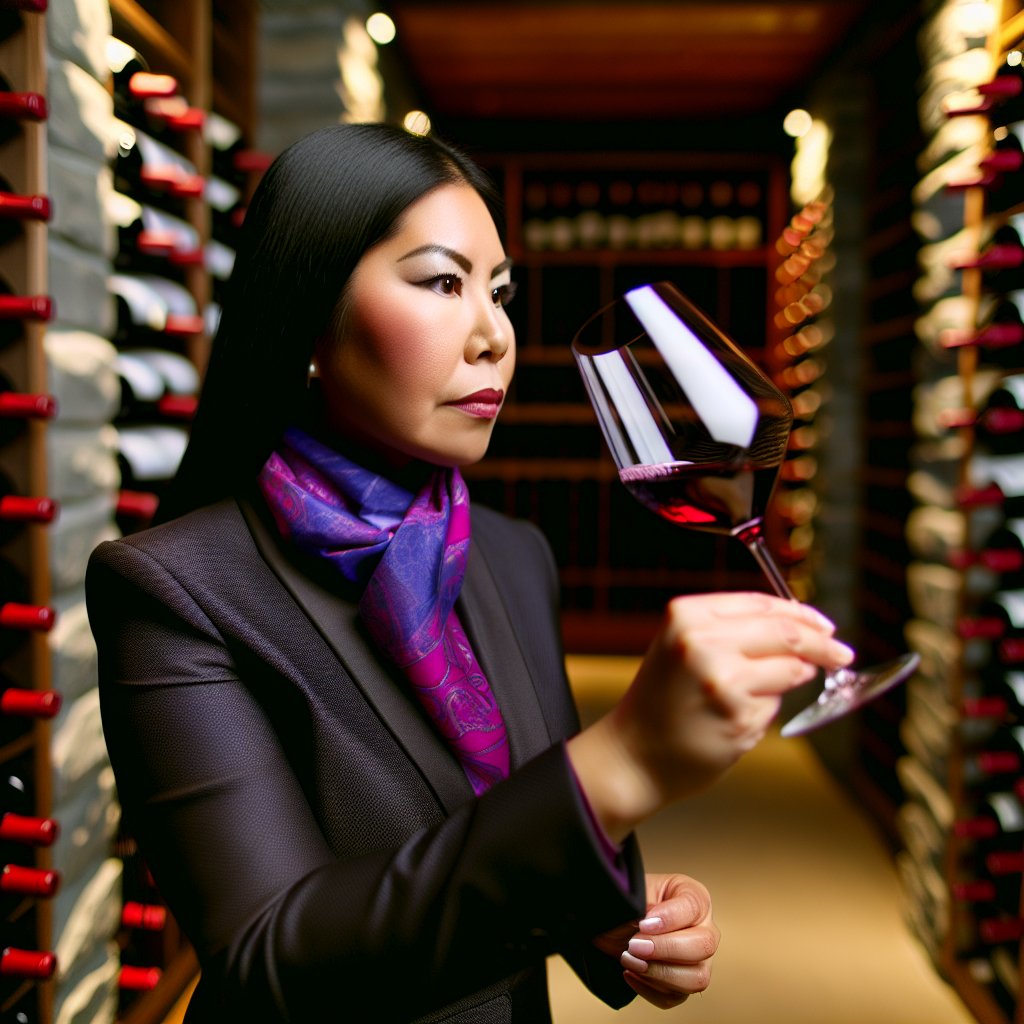Understanding the Role and Responsibilities of a Sommelier
Defining the Sommelier’s Role
A sommelier is a wine professional who specializes in all aspects of wine service.
They often work in fine dining restaurants and upscale venues.
Moreover, sommeliers are responsible for curating wine lists to complement food menus.
Key Responsibilities
Sommeliers perform several essential tasks in their role.
- They recommend wine pairings based on guest preferences.
- Sommeliers oversee wine storage and inventory management.
- They conduct wine tastings and training sessions for staff.
- Furthermore, they stay current on wine trends and regions.
Essential Skills for Success
Successful sommeliers possess a unique skill set.
First, they must have a deep knowledge of different wine varieties.
Additionally, they should excel in communicating with guests.
Furthermore, they must have strong sensory skills to identify flavors.
The Importance of Customer Service
Customer service forms the backbone of a sommelier’s role.
They interact with guests to enhance their dining experience.
Good sommeliers build rapport and trust with patrons.
Ultimately, their goal is to provide unforgettable experiences.
Working with Culinary Teams
Collaboration with chefs is vital for a sommelier.
They ensure wine and food pairings delight the palate.
This teamwork enhances the overall dining experience.
Moreover, it fosters creative opportunities for special events.
Essential Qualifications and Certifications for Aspiring Sommeliers
Understanding the Role of a Sommelier
A sommelier is a wine expert responsible for wine service and selection.
This role requires a deep understanding of different wine varieties.
Knowledge of food pairings and wine regions is essential as well.
Educational Background
A formal education in hospitality can be beneficial for sommeliers.
Many sommeliers hold degrees in wine studies or culinary arts.
Some prestigious programs focus specifically on wine and spirits.
Recommended Wine Programs
- The Court of Master Sommeliers offers a respected certification track.
- The Wine & Spirit Education Trust (WSET) provides globally recognized qualifications.
- Many universities now offer degree programs in viticulture and enology.
Essential Certifications
Certifications enhance credibility and expand knowledge for aspiring sommeliers.
Consider pursuing the Certified Sommelier designation as a starting point.
Advanced certifications lead to mastering the art of wine tasting.
Unlock Your Career Potential
Visualize a clear path to success with our tailored Career Consulting service. Personalized insights in just 1-3 days.
Get StartedPopular Certification Paths
- Master Sommelier is the pinnacle of wine expertise.
- WSET offers levels ranging from beginner to advanced.
- Certified Specialist of Wine (CSW) focuses on global wine education.
Gaining Practical Experience
Hands-on experience is invaluable in the journey to becoming a sommelier.
Work in various hospitality settings to gain practical skills.
Consider internships at wineries or fine dining restaurants.
Building a Network
Networking is crucial in the wine industry.
Attend wine tastings, trade shows, and industry events whenever possible.
Establish connections with experienced sommeliers and wine distributors.
Ongoing Education and Tasting
Continuing education keeps knowledge current in a dynamic industry.
Regularly participate in tastings to refine your palate.
Stay informed about new wine trends and regions.
Recommended Resources
- Wine books and magazines provide insights into current offerings.
- Online courses can enhance your specific knowledge areas.
- Join local wine clubs to expand your tasting experiences.
Exploring Wine Regions and Varietals
Understanding Wine Regions
Geography plays a crucial role in winemaking.
Different regions produce distinct flavor profiles.
Some famous wine regions include Bordeaux, Napa Valley, and Tuscany.
Each area has its climate that affects grape growth.
Researching these regions can enhance your wine knowledge.
Visit wineries to gain firsthand experience of local production.
Key Wine Regions to Explore
- Bordeaux: Renowned for its blends, particularly Cabernet Sauvignon.
- Napa Valley: Known for rich Cabernet Sauvignon and Chardonnay.
- Tuscany: Famous for its Sangiovese and robust reds.
- Willamette Valley: Recognized for high-quality Pinot Noir.
- Barossa Valley: Celebrated for bold Shiraz wines.
Diving into Wine Varietals
Wine varietals are specific types of grapes used in winemaking.
Familiarizing yourself with common varietals is essential.
Each varietal has unique characteristics and flavor profiles.
For instance, Merlot is soft and fruity, while Cabernet Sauvignon is bold.
Understanding these nuances improves your tasting skills.
Popular Wine Varietals to Sample
- Chardonnay: A versatile white grape with oak and fruit notes.
- Pinot Noir: A delicate red grape known for its earthy flavors.
- Sauvignon Blanc: Crisp and refreshing, often with herbal touches.
- Zinfandel: Fruit-forward, with spicy undertones.
- Riesling: Aromatic and known for its sweetness and acidity.
Tips for Beginner Wine Enthusiasts
Start by tasting wines from different regions and varietals.
Take notes on what you enjoy and why.
Attend local wine tastings to expand your palate.
Consider joining a wine club for curated selections.
Lastly, don’t hesitate to ask questions; it deepens your understanding.
See Related Content: Sustainable Practices In Spa Management
Developing Tasting Skills
Understanding Flavor Profiles
Begin by familiarizing yourself with common flavor profiles in wine.
Many wines exhibit fruit, herbaceous, or earthy notes.
For example, Cabernet Sauvignon often tastes of dark fruits like blackcurrant.
In contrast, a Sauvignon Blanc may highlight citrus and herbal nuances.
Take notes as you taste to improve your ability to identify flavors.
Practicing Aroma Recognition
Aroma recognition is crucial for a sommelier.
To develop this skill, create an aroma kit.
Fill it with common scents found in wines, such as vanilla and oak.
Regularly practice identifying these scents while tasting different wines.
Additionally, consider using everyday items like fruits and spices for comparison.
Effective Tasting Techniques
When tasting, use a systematic approach for accuracy.
Start with visual examination: assess the color and clarity of the wine.
Next, swirl the glass gently to release aromas.
Then, take a moment to inhale deeply before tasting.
Finally, allow the wine to linger on your palate to identify flavors.
Joining Tasting Groups
Consider joining a local wine tasting group.
These groups often provide a range of wines to sample.
You can learn from more experienced tasters.
Additionally, participating in discussions enhances your understanding of wine.
Networking with fellow enthusiasts can broaden your exposure to diverse wines.
Continuing Education and Certification
To elevate your skills, pursue formal education.
Many institutions offer sommelier certification programs.
Courses often include tasting techniques and wine pairings.
Furthermore, attending workshops can refine your palate.
Investing time in education will deepen your wine knowledge.
Learn More: The Importance of Customer Service in Concierge Work
Building a Personal Wine Collection
Choosing the Right Wines
Begin by identifying your personal taste preferences.
Explore various wine styles, such as reds, whites, and sparkling wines.
Additionally, taste wines from different regions to broaden your palate.
Join tastings to gain insights from sommeliers and fellow wine enthusiasts.
Make a list of wines you enjoy to guide future purchases.
Consider investing in wines from reputable vineyards.
Pay attention to vintage quality as it affects wine value and taste.
Moreover, seek out wines that you can enjoy both now and later.
Storing Your Collection
Proper storage is essential for preserving wine quality.
Choose a cool, dark place with consistent temperatures for storage.
Avoid locations with frequent temperature fluctuations, like garages.
Invest in a wine fridge if indoor conditions are not ideal.
Maintain humidity levels between 50% and 70% to prevent cork deterioration.
Store bottles horizontally to keep the cork moist and prevent air exposure.
Lastly, keep your collection organized for easy access.
Expanding Your Collection
Set a budget to manage your wine purchases effectively.
Consider joining a wine club for regular deliveries of curated selections.
Attend local wine events to discover new options and trends.
Network with fellow wine lovers to share recommendations and tips.
Document your collection to track which bottles you own and their value.
Finally, remain patient as you build your collection over time.
Explore Further: Why Concierge Services Are Essential in Modern Living

The Importance of Food Pairing
Enhancing the Dining Experience with Wine
Food pairing plays a crucial role in elevating a meal.
When done correctly, it creates a harmonious balance of flavors.
Wine enhances the taste of food and vice versa.
Therefore, understanding wine profiles becomes essential.
Each wine carries unique characteristics, such as acidity, sweetness, and tannins.
These elements interact with different food items significantly.
For instance, pairing white wine with seafood is a classic choice.
The acidity in white wine complements the delicate flavors of fish.
Similarly, red wine often pairs well with meat dishes.
Tannins in red wine soften the richness of hearty meals.
Additionally, spicy foods benefit from sweeter wines.
The sweetness can counteract the heat of spicy ingredients.
Key Principles of Food and Wine Pairing
Several principles help guide successful pairings.
One important rule is matching weight and intensity.
Heavier dishes demand fuller-bodied wines for balance.
Another principle involves contrasting flavors.
A bitter dish can benefit from a sweet wine, enhancing the overall experience.
Exploring Regional Pairings
Different regions often present unique pairing traditions.
For instance, Italian wines pair beautifully with Mediterranean cuisine.
Local ingredients and flavors often inform these pairings.
Therefore, exploring a region’s culinary traditions is beneficial.
Moreover, seasonal foods can influence wine selections.
Fresh summer salads may call for light, crisp wines.
Conversely, hearty winter dishes might require robust reds.
Experimenting with Pairings
Encouraging experimentation can lead to delightful discoveries.
Every palate is unique, making personal preferences important.
Trying unexpected combinations can yield surprising results.
For example, pairing fruity wines with savory cheeses can be rewarding.
Continuously refining one’s palate enhances the dining experience.
Uncover the Details: How Sommeliers Train Their Palate for Wine Analysis
Networking and Building Relationships within the Wine Industry
Importance of Networking
Networking is essential for career growth in the wine industry.
It opens doors to new opportunities and valuable connections.
Furthermore, personal relationships can lead to career advancements.
Engaging with Wine Professionals
Attend wine tastings and industry events regularly.
These environments offer great networking opportunities.
Don’t hesitate to introduce yourself to industry veterans.
Show genuine interest in their work and experiences.
Leveraging Social Media
Utilize platforms like LinkedIn and Instagram to connect with professionals.
Share your wine experiences and insights to attract attention.
Follow sommeliers and wineries to stay informed about trends.
Joining Professional Associations
Consider joining organizations like the Court of Master Sommeliers.
Membership provides access to exclusive networking opportunities.
Participate in workshops and seminars offered by these associations.
Building Relationships with Wineries
Establish connections with local wineries and vineyards.
Visit them and participate in their events and tastings.
These visits can deepen your knowledge of their products.
Additionally, inquire about internships or volunteer opportunities.
Staying Informed
Subscribe to industry publications and newsletters.
Being informed assists in meaningful conversations with peers.
Moreover, it demonstrates your commitment to the profession.
Collaborating with Peers
Collaborate with fellow sommeliers and wine enthusiasts.
Working together on projects fosters strong professional bonds.
Attend workshops or trainings as a group to enhance skills.
Staying Updated with Trends
Importance of Continuous Education
Continuous education is vital for every sommelier’s growth.
New wine trends and techniques constantly emerge.
Staying updated ensures you remain competitive in the industry.
Resources for Sommeliers
Numerous resources help sommeliers advance their knowledge.
Books such as “The World Atlas of Wine” offer valuable insights.
Online platforms like MasterClass provide expert courses.
Subscriptions to wine magazines can deepen your understanding.
Attending Workshops and Seminars
Participating in workshops enhances practical skills.
Look for local wine schools offering hands-on experience.
Networking opportunities often arise during these events.
Joining Professional Associations
Joining organizations helps expand your professional network.
The Court of Master Sommeliers offers valuable resources.
Membership often includes access to exclusive events.
Utilizing Tasting Groups
Engaging in tasting groups fosters peer learning.
Regular tastings expose you to a variety of wines.
Members can share personal insights and experiences.
Following Industry Trends
Stay informed about emerging wine regions and varietals.
Reading the latest wine reports and publications helps.
Engaging on social media keeps you connected with trends.
Additional Resources
American vs. European Sommeliers: Exploring the Cultural …
Opinion | My Restaurant Was Named One of New York City’s Best …




